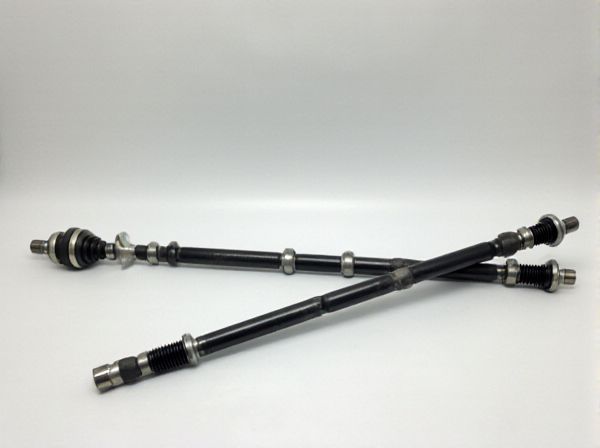
Photo illustration: Eccentric Shaft vs Straight Shaft
An eccentric shaft features an offset design that converts rotary motion into reciprocating motion, enhancing mechanical efficiency in engines and pumps. A straight shaft has a uniform diameter and is primarily used for transmitting torque and rotation without altering motion patterns. Understanding the difference helps you select the right component for specific mechanical functions and performance requirements.
Table of Comparison
| Feature | Eccentric Shaft | Straight Shaft |
|---|---|---|
| Design | Off-center axis for variable motion | Centered axis for uniform rotation |
| Function | Converts rotary motion to reciprocating motion | Transfers torque with consistent rotation |
| Applications | Used in variable valve timing, pumps | Common in drive axles, transmission shafts |
| Durability | Higher wear due to off-center load | Better durability with balanced load |
| Manufacturing Complexity | More complex machining process | Simple, cost-effective production |
| Cost | Generally more expensive | Economical choice |
Introduction to Eccentric and Straight Shafts
Eccentric shafts feature an offset centerline allowing for rotary motion combined with reciprocating or oscillating movement, commonly used in pumps and engines to convert circular motion into linear or reciprocating action. Straight shafts maintain a uniform centerline and are primarily designed for transmitting rotary power between components in machinery, such as in motors and gearboxes. Understanding the distinct structural designs and mechanical functions of eccentric and straight shafts is essential for selecting the appropriate shaft type in various industrial and automotive applications.
Definition and Key Differences
An eccentric shaft features an off-center axis designed to convert rotary motion into reciprocating motion, commonly used in compressors and pumps. A straight shaft has a uniform, centered axis that primarily transmits rotational power directly without altering motion type, typical in engines and turbines. The key difference lies in the eccentric shaft's ability to create non-circular movement patterns, while the straight shaft maintains consistent rotational dynamics.
Design and Structural Comparison
The eccentric shaft features an offset axis relative to its main rotation center, enabling conversion of rotary motion into reciprocating motion, commonly used in engines and compressors. In contrast, the straight shaft has a uniform, centered axis ideal for transmitting torque without altering motion types, prevalent in driveshafts and turbines. Structurally, the eccentric shaft requires precise balancing and reinforcement to handle uneven loads and stress concentrations, while the straight shaft design emphasizes uniform strength and simpler manufacturing processes.
Mechanical Functionality
Eccentric shafts convert rotational motion into linear motion through an offset design, enabling precise control in applications like pumps and compressors. Straight shafts transmit torque and rotational motion without altering the axis, providing uniform power transfer and structural simplicity in machinery. The choice between eccentric and straight shafts depends on the need for motion conversion versus straightforward rotational force transmission.
Advantages of Eccentric Shafts
Eccentric shafts provide superior mechanical advantage by enabling precise conversion of rotary motion into reciprocating motion, essential for efficient piston movement in compressors and pumps. Their offset design reduces wear and tear on bearings and increases load distribution, enhancing the durability and reliability of the machinery. Eccentric shafts also allow for smoother operation and better control of stroke length compared to straight shafts, improving overall performance and energy efficiency.
Benefits of Straight Shafts
Straight shafts offer superior alignment and balance compared to eccentric shafts, reducing vibration and wear in mechanical systems. Their uniform geometry simplifies manufacturing and maintenance, resulting in increased durability and lower operational costs. Straight shafts also enhance power transmission efficiency by minimizing stress concentrations and ensuring consistent rotational motion.
Typical Applications in Industry
Eccentric shafts are commonly utilized in machinery requiring converting rotary motion into linear motion, such as in pumps, compressors, and cam-driven systems, providing precise control over displacement. Straight shafts are predominantly found in applications needing straightforward torque transmission, like conveyors, motors, and drive systems, ensuring efficient rotational power transfer. Choosing between eccentric and straight shafts depends largely on the mechanical function, with eccentric shafts excelling in reciprocating mechanisms and straight shafts in rotational power delivery.
Performance Efficiency Analysis
Eccentric shafts enhance performance efficiency by converting rotational motion into precise reciprocating motion, reducing vibration and energy loss in mechanical systems. Straight shafts offer simpler design and lower manufacturing costs but may experience higher friction and wear due to less efficient force distribution. In applications demanding high precision and durability, eccentric shafts outperform straight shafts by optimizing torque transmission and minimizing mechanical stress.
Maintenance and Durability Concerns
Eccentric shafts require frequent maintenance due to uneven wear caused by their off-center rotation, which can lead to increased vibration and potential misalignment. Straight shafts generally offer better durability with simpler maintenance routines as their uniform rotation reduces stress concentrations and wear patterns. Proper lubrication and regular inspection are crucial for both types to ensure longevity and optimal performance.
Choosing the Right Shaft for Your Application
Choosing the right shaft between eccentric and straight designs depends on the mechanical requirements and motion control of your application. Eccentric shafts offer precise rotational offset essential for converting rotary motion to reciprocating motion in pumps and compressors, while straight shafts provide uniform rotation ideal for transmitting torque in motors and drives. Evaluating factors such as load type, rotational speed, and alignment needs ensures optimal performance and longevity in your machinery.
 caratoz.com
caratoz.com